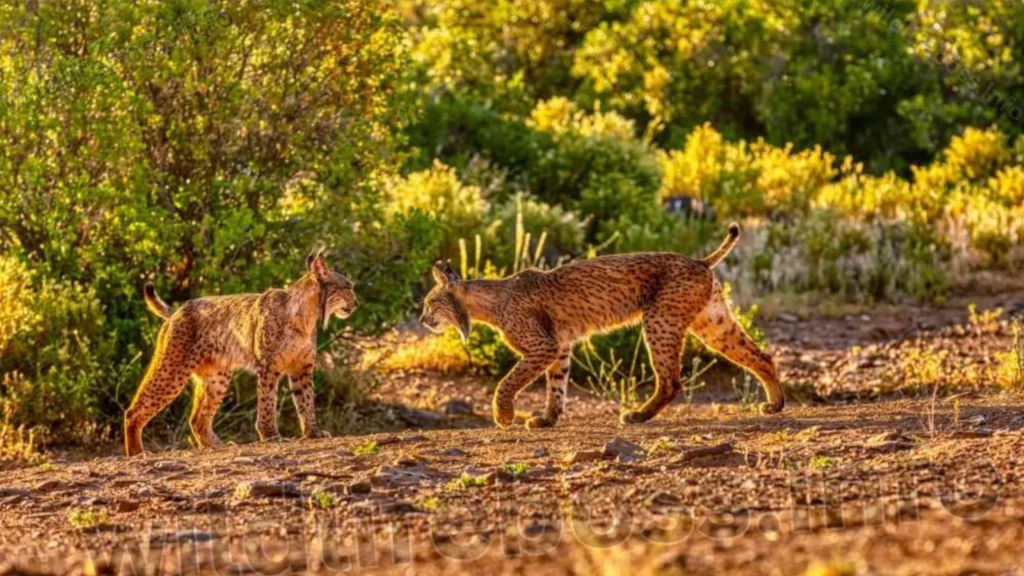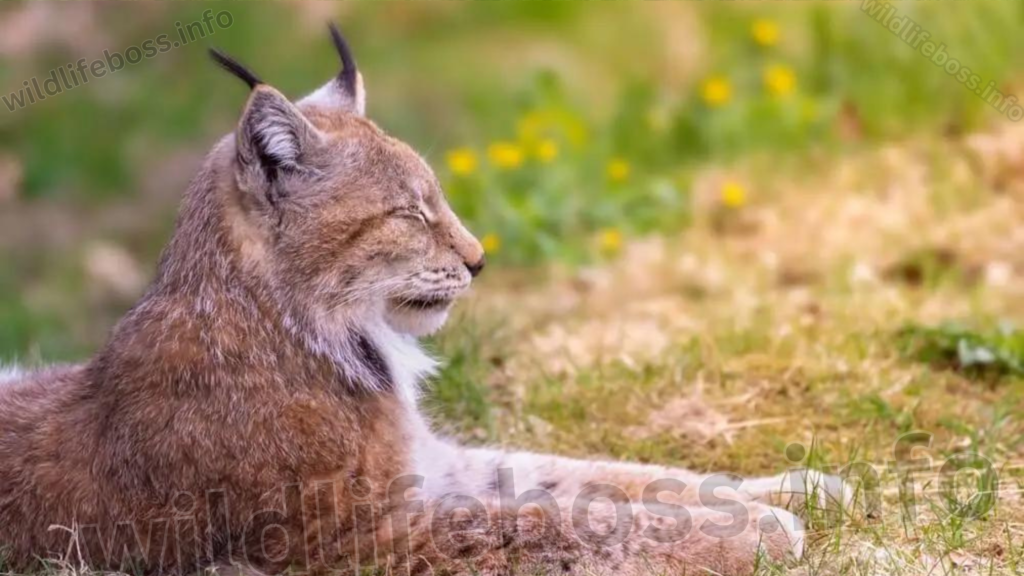As it looks for prey in the dark hours, the elusive bobcat is frequently silent and invisible.
But during the night, they let forth cries that are so loud and startling that they startle individuals out of their deep slumber.
Bobcats may make a variety of noises, including growling, hissing, meowing, and purring, just like other small cats. However, they produce powerful vocalizations that mimic screams during the breeding season. Together with growling and hissing, bobcats often make cough-bark noises to frighten away larger predators. When hunting, they keep silent to give the impression that they are surprising their victim.
The reader will learn about the numerous sounds made by bobcats sound and the reasons behind them in this article. Continue reading.
Bobcat Sound And Why They Make Them
The felidae family comprises 37 distinct cat species, including the domestic cat, cheetah, leopard, lion, and bobcat (Lynx rufus).
They are also called a wildcat or bay lynx, which is well named given their bobbed tails.
Although they are generally nocturnal and elusive, bobcats can occasionally be sighted hunting during the day. Although they usually keep to themselves, bobcats can make a variety of noises when necessary.
The bobcat has a characteristic cry, but it also makes many sounds similar to those of a domestic cat. If you are unlucky enough to not see a bobcat, you may still hear one howling, especially at night.
Sea also: Lynx Vs Bobcat(15 Best Differences)
8 Bobcat Sounds And Their Significance:

1.High-Pitched Scream
Bobcats are solitary creatures who relocate every day. When a female has a litter of one to six kittens, she will have multiple dens and use them alternately.
On the other hand, bobcats socialize a lot with one another during the mating season, which runs from January to May. They usually make the most noise at this time.
At this time, bobcats make a sound known as caterwauling, which many describe as sounding like a lady yelling for aid.
This bobcats sound can also be described as a guy yelling, a sobbing child, or evil-sounding (with discordant tones).
It may even sound like the mating animals are killing each other when this scream is at its loudest and most often during the breeding season.
When bobcats sounds are mating or competing for a female, they can also be heard growling, hissing, and growling.
2.Cough-Bark(Barking)
The cough-bark is the only sound that is specific to bobcats sound. Its name comes from its abrupt, brief sound and its echoing, raspy tone. Bobcats typically use their cough-bark as a defense mechanism when they sense danger. It can be utilized to alert others in the area to a threat.
Though the cough-bark is the most typical, the bobcat can also make various types of barking sounds. Their tiny barks may resemble a bird’s chirping more than any other sound, such as a cough.
3.Purring

Because of linked, tiny bones called hyoid bones that extend from the base of the skull to the back of the tongue, smaller cats, like bobcats sound, are able to purr but not roar.
The cat’s voice box, or larynx, vibrates these U-shaped bones, which reverberate and enable the cat to breathe continuously. The idea behind purring is that a mother’s purr might hide her nursing offspring’ mewing from potential predators.
4.Meows
Meowing is similar to hissing; if you have a cat or have been around cats in the past, you may be familiar with it. Even though bobcats sound don’t have the same meow as your typical housecat, they nevertheless use it as a means of communication.
In bobcats sound, meowing is an uncommon phenomenon.
5.Squalls
Another uncommon sound made by bobcats is the squall. This is due to the fact that the bobcat only makes this harsh sound when it is hurt or scared. It sounds like the yowl your housecat lets out when something frightens them or steps on their tail.
6.Growls

Barking and growling are similar in that they both indicate a bobcat’s sense of threat. A bobcats sound like growl, as opposed to its bark, indicates that it intends to defend both its territory and itself. Note that the sound is not loud, even if it can have a deep, guttural quality. Because of this, if you hear a bobcat growling, you are in its proximity and should safely get away from it.
Bobcats tend to growl more frequently in the breeding season. This is due to their fierce territorial defense instinct, which makes them more inclined to confront intruders head-on in an effort to ward off predators.
7.Hissing
Hissing sounds like a growl. It indicates that the bobcats sound may attack if it feels threatened. Another subtle sound that indicates you are getting close to the bobcat is their hiss.
A bobcat’s hiss is similar to that of a house cat. Because of this, if you are familiar with scared cats, you might be able to recognize the sound more easily.
8.Howls
Although you might associate howling with wolves and dogs, bobcats can also howl. Their howls, though, are very dissimilar from those of canine species.
The howl of a bobcat resembles their scream more than that of any other dog. Furthermore, bobcats use their howls, which are similar to their high-pitched screams, to interact with possible mates. When it’s not mating season, bobcats may use this sound, similar to their meows, to connect with other animals.
Alerts
Bobcats are highly perceptive, auditory, and olfactory animals that can identify both food and potential threats. During the dawn and sunset hours, bobcats often hunt at twilight, or crepuscular light.
Bobcats sound will growl, hiss, or howl in reaction to a predator threat, much like they do when they cough.
In order to give domestic dogs—and other predators—time to flee to safer ground or climb a tree, these sounds are designed to frighten or repel them.
Territory
When a bobcat is approaching, these vocalizations are used as well to demonstrate power or defend territory.
Bobcats can be found in many different types of habitats with sufficient surface cover, including scrublands, coastal marshes, woods, and deserts.
They may live in modified ecosystems, including suburban areas, and are tolerant of human interference.
Southern Canada, all 48 contiguous states (apart from Delaware), and southern Mexico are among the regions where bobcats sound can be found.
The circumscribed area of a female’s territory is roughly 6 square miles, whereas a male’s territory can span up to 60 square miles.
There are an estimated 23 million bobcats in the United States alone, and their number is rising.
Mating
Along with the screams of mating, one can also hear howls, hisses, and growls.

sea also: How High Can Bobcats Jump? 5 Amazing Comparison(with photos)
No bobcats Sound
When hunting small and midsize prey, such as birds, squirrels, fawns, raccoons, and rabbits, bobcats will typically remain silent and covert.
They grab the animal by the neck and damage its spinal cord in one rapid motion. The bobcat will keep and cover any food left in its stomach before returning for more at a later time if it has eaten its fill.
Conclusion
Bobcats travel about their areas and hunt in silence most of the time. Bobcats sound are able to hiss, growl, meow, and purr, just like domestic cats. In order to intimidate larger predators, they also make hostile sounds, such as cough-barks.
Most notably, from January to May, while they are reproducing, bobcats vocalize loudly at night, like screams.
Frequently Ask Question(FAQs):
How can you determine whether a bobcat is nearby?
Bobcats often scrape the ground in order to make a spot for their urinal. They occasionally scrape to conceal their scat. Additionally, bobcats will build smell mounds by building a small, six-inch-tall mound then spraying backward onto it. The characteristic fragrance of housecat urine is also present in bobcat urine.
Do bobcats have a howling voice?
Bobcats sound, particularly in the breeding season, produce an ear-piercing scream, howl, and cry.
Does a bobcat have a cat-like meow?
The National Zoo and Conservation Biology Institute of the Smithsonian states that bobcats sound frequently “chortle and make birdlike chirps” as opposed to meowing.
Is a bobcat afraid of people?
We scare the bobcats sound far less than they scare us. When bobcats sound discover free supplies of food linked with humans (pet food left on porches, for example) and have consistent interactions with people without any bad outcomes, they may outgrow their innate dread of people.
What sounds are made by sad cats?
A howl or yowl, which resemble loud, prolonged meows, indicates that your cat is experiencing difficulty of some sort, such as being trapped in a closet, hurt, or searching for you. If your cat is making this sounds, go find them. These noises are a normal aspect of mating activity in cats, though.
What large cat cannot roar?
The cheetah is one large animal that can purr but not roar. Because it cannot fully retract its claws, biologists have placed it in an own genus, Acinyx. The cheetah is also known for its high-pitched chirp, which is thought to be similar to a canary’s.


Pingback: Do Bobcats Have Tails? Best Explaination - Wildlifeboss.info